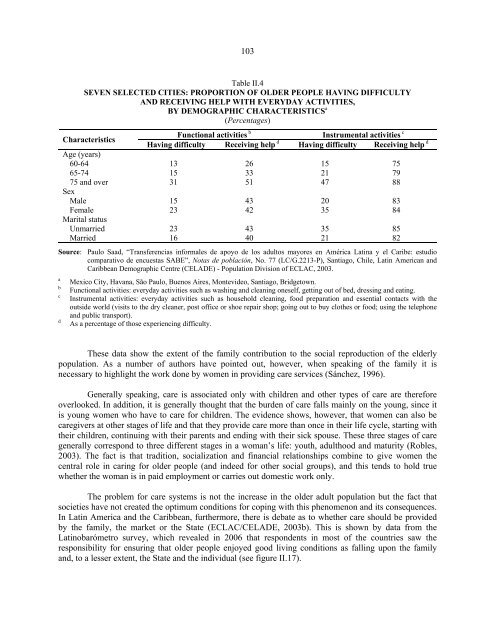Women in Latin America and the Caribbean - Cepal
Women in Latin America and the Caribbean - Cepal
Women in Latin America and the Caribbean - Cepal
Create successful ePaper yourself
Turn your PDF publications into a flip-book with our unique Google optimized e-Paper software.
103<br />
Table II.4<br />
SEVEN SELECTED CITIES: PROPORTION OF OLDER PEOPLE HAVING DIFFICULTY<br />
AND RECEIVING HELP WITH EVERYDAY ACTIVITIES,<br />
BY DEMOGRAPHIC CHARACTERISTICS a<br />
(Percentages)<br />
Characteristics<br />
Functional activities b<br />
Instrumental activities c<br />
Hav<strong>in</strong>g difficulty Receiv<strong>in</strong>g help d Hav<strong>in</strong>g difficulty Receiv<strong>in</strong>g help d<br />
Age (years)<br />
60-64 13 26 15 75<br />
65-74 15 33 21 79<br />
75 <strong>and</strong> over 31 51 47 88<br />
Sex<br />
Male 15 43 20 83<br />
Female 23 42 35 84<br />
Marital status<br />
Unmarried 23 43 35 85<br />
Married 16 40 21 82<br />
Source: Paulo Saad, “Transferencias <strong>in</strong>formales de apoyo de los adultos mayores en América Lat<strong>in</strong>a y el Caribe: estudio<br />
comparativo de encuestas SABE”, Notas de población, No. 77 (LC/G.2213-P), Santiago, Chile, Lat<strong>in</strong> <strong>America</strong>n <strong>and</strong><br />
<strong>Caribbean</strong> Demographic Centre (CELADE) - Population Division of ECLAC, 2003.<br />
a<br />
b<br />
c<br />
d<br />
Mexico City, Havana, São Paulo, Buenos Aires, Montevideo, Santiago, Bridgetown.<br />
Functional activities: everyday activities such as wash<strong>in</strong>g <strong>and</strong> clean<strong>in</strong>g oneself, gett<strong>in</strong>g out of bed, dress<strong>in</strong>g <strong>and</strong> eat<strong>in</strong>g.<br />
Instrumental activities: everyday activities such as household clean<strong>in</strong>g, food preparation <strong>and</strong> essential contacts with <strong>the</strong><br />
outside world (visits to <strong>the</strong> dry cleaner, post office or shoe repair shop; go<strong>in</strong>g out to buy clo<strong>the</strong>s or food; us<strong>in</strong>g <strong>the</strong> telephone<br />
<strong>and</strong> public transport).<br />
As a percentage of those experienc<strong>in</strong>g difficulty.<br />
These data show <strong>the</strong> extent of <strong>the</strong> family contribution to <strong>the</strong> social reproduction of <strong>the</strong> elderly<br />
population. As a number of authors have po<strong>in</strong>ted out, however, when speak<strong>in</strong>g of <strong>the</strong> family it is<br />
necessary to highlight <strong>the</strong> work done by women <strong>in</strong> provid<strong>in</strong>g care services (Sánchez, 1996).<br />
Generally speak<strong>in</strong>g, care is associated only with children <strong>and</strong> o<strong>the</strong>r types of care are <strong>the</strong>refore<br />
overlooked. In addition, it is generally thought that <strong>the</strong> burden of care falls ma<strong>in</strong>ly on <strong>the</strong> young, s<strong>in</strong>ce it<br />
is young women who have to care for children. The evidence shows, however, that women can also be<br />
caregivers at o<strong>the</strong>r stages of life <strong>and</strong> that <strong>the</strong>y provide care more than once <strong>in</strong> <strong>the</strong>ir life cycle, start<strong>in</strong>g with<br />
<strong>the</strong>ir children, cont<strong>in</strong>u<strong>in</strong>g with <strong>the</strong>ir parents <strong>and</strong> end<strong>in</strong>g with <strong>the</strong>ir sick spouse. These three stages of care<br />
generally correspond to three different stages <strong>in</strong> a woman’s life: youth, adulthood <strong>and</strong> maturity (Robles,<br />
2003). The fact is that tradition, socialization <strong>and</strong> f<strong>in</strong>ancial relationships comb<strong>in</strong>e to give women <strong>the</strong><br />
central role <strong>in</strong> car<strong>in</strong>g for older people (<strong>and</strong> <strong>in</strong>deed for o<strong>the</strong>r social groups), <strong>and</strong> this tends to hold true<br />
whe<strong>the</strong>r <strong>the</strong> woman is <strong>in</strong> paid employment or carries out domestic work only.<br />
The problem for care systems is not <strong>the</strong> <strong>in</strong>crease <strong>in</strong> <strong>the</strong> older adult population but <strong>the</strong> fact that<br />
societies have not created <strong>the</strong> optimum conditions for cop<strong>in</strong>g with this phenomenon <strong>and</strong> its consequences.<br />
In Lat<strong>in</strong> <strong>America</strong> <strong>and</strong> <strong>the</strong> <strong>Caribbean</strong>, fur<strong>the</strong>rmore, <strong>the</strong>re is debate as to whe<strong>the</strong>r care should be provided<br />
by <strong>the</strong> family, <strong>the</strong> market or <strong>the</strong> State (ECLAC/CELADE, 2003b). This is shown by data from <strong>the</strong><br />
Lat<strong>in</strong>obarómetro survey, which revealed <strong>in</strong> 2006 that respondents <strong>in</strong> most of <strong>the</strong> countries saw <strong>the</strong><br />
responsibility for ensur<strong>in</strong>g that older people enjoyed good liv<strong>in</strong>g conditions as fall<strong>in</strong>g upon <strong>the</strong> family<br />
<strong>and</strong>, to a lesser extent, <strong>the</strong> State <strong>and</strong> <strong>the</strong> <strong>in</strong>dividual (see figure II.17).











